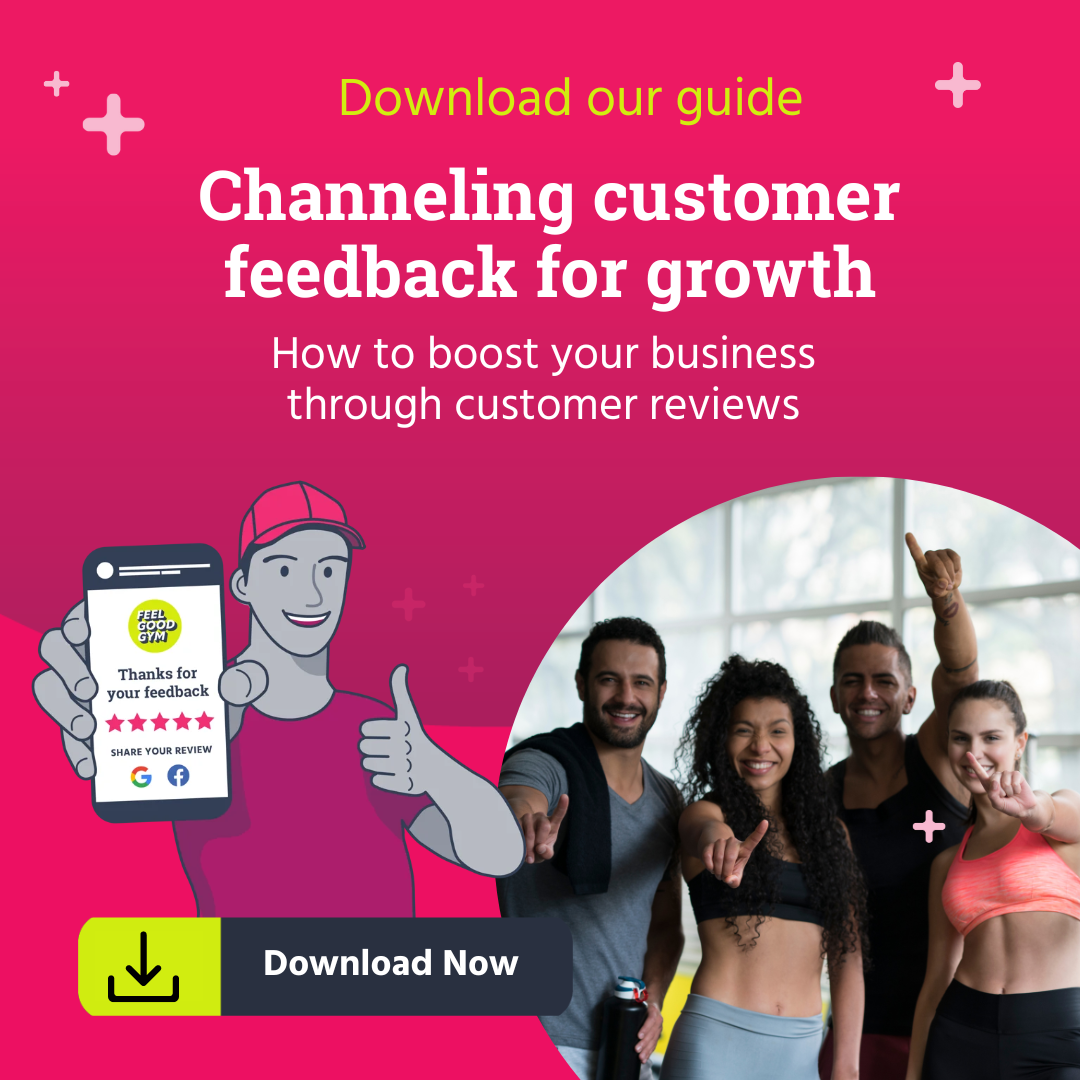Cash flow, representing the movement of money in and out of business, is crucial for gym owners. A positive cash flow allows a gym to sustain operations, while a negative one can hinder even the most popular establishments.
While many believe high membership numbers guarantee success, the reality is different: even packed gyms can struggle if cash flow isn't optimized. With rising operational costs and stiff competition in the fitness industry, savvy financial management is essential.
Find the best ways to use customer reviews
to grow your business
DOWNLOAD NOW 
What is cash flow optimization?
Cash flow optimization is a financial strategy that focuses on balancing and managing the inflow and outflow of cash in your gym business.
Its primary aim is to ensure that the cash coming into the business from memberships, personal training services, and merchandise sales is more than the cash for expenses like salaries, utilities, equipment maintenance, and rent. It's a measure of your business' financial health and sustainability.
At its core, cash flow optimization involves:
- Increasing income: This could be achieved by attracting more members, offering new services, or upselling existing ones.
- Reducing expenses: This might mean negotiating better terms with suppliers, reducing energy consumption, or finding more cost-effective marketing strategies.
- Improving the timing of cash flows: This involves managing when money comes in and goes out to ensure there's always enough cash on hand.
10 strategies to optimize cash flow for gym owners
1. Understand your cash flow
Understanding your cash flow is critical to successfully managing a fitness business. A clear grasp of where money is coming from and where it's going ensures that the business remains solvent, can pay its bills on time, and can reinvest in growth opportunities.
The benefits of closely monitoring and understanding cash flow are numerous. Firstly, it clarifies the business' financial health, allowing for informed decision-making.
It also helps identify potential financial challenges in advance, allowing businesses to strategize and avoid potential pitfalls.
2. Reduce overhead costs
Overhead costs, such as rent, utilities, equipment maintenance, and staff salaries, can quickly add up, eating into a gym's profits.
By streamlining these costs, businesses can increase their profitability, ensuring they remain competitive and sustainable in the long run.
For instance, a gym that saves on utility bills by implementing energy-efficient measures can redirect those funds towards marketing campaigns or upgrading equipment, enhancing the overall member experience.
3. Negotiate with vendors
Negotiating with vendors is about reducing costs and building long-term relationships that bring value to both parties.
For example, securing a deal with an equipment supplier might mean access to the latest fitness gear before competitors or receiving extended warranty terms. This enhances the member experience and positions the fitness center as a forward-thinking establishment.
To successfully negotiate with vendors, fitness businesses should be well-prepared. This involves understanding market rates, being clear about requirements, and being willing to explore alternative vendors if terms aren't favorable.
It's also beneficial to approach negotiations as a partnership rather than a transaction. This mindset fosters mutual respect and understanding, paving the way for deals that benefit the fitness business and the vendor.
4. Implement a membership tier system
A tiered membership system allows potential members to choose a package that aligns with their fitness goals, usage frequency, and budget.
A basic tier might offer limited access to gym facilities during off-peak hours, while a premium tier could include unlimited access, personal training sessions, and access to specialty classes. This flexibility can make gym memberships more accessible and attractive to a wider range of individuals.
From a revenue perspective, tiered memberships can optimize cash flow. In comparison, basic memberships attract higher volumes of members due to their affordability, while premium memberships, though fewer in number, can generate significant revenue due to their higher price point. Besides, members can upgrade their tiers as their commitment to fitness grows, creating an additional revenue stream for the business.
5. Offer discounts for long-term memberships
When paired with discounts, long-term memberships present a win-win situation for the gym and its members.
For members, it translates to cost savings over time, giving them more reason to stick around and stay committed to their fitness journey.
For the fitness center, it means reduced administrative tasks related to monthly renewals and a more predictable cash flow.
This stability can be crucial, especially in an industry where seasonal fluctuations, like the infamous New Year resolution sign-ups, can lead to varying membership counts throughout the year.
Members committing to longer terms are more likely to integrate a fitness routine into their daily lives, leading to better health outcomes. This success can then be showcased as testimonials or success stories — powerful marketing tools to attract new members.
6. Streamline your payment process
Streamlining the payment process can significantly impact member satisfaction and operational efficiency. A seamless payment system reduces friction for members, making it easier to join, renew memberships, or purchase additional services.
Members who can effortlessly complete transactions enhance their overall experience, leading to increased loyalty and positive word-of-mouth referrals.
From an operational perspective, an efficient payment process reduces administrative burdens. Automated billing, for instance, minimizes the chances of errors, ensuring accurate and timely revenue collection.
It also aids in cash flow management, as predictable and regular income can be better planned for business growth and reinvestment.
7. Create and follow a budget
Creating and adhering to a budget is foundational for any fitness business aiming for financial stability and growth. By mapping out expected revenues and expenses, businesses can gain a clear picture of their financial health, identify potential areas of savings, and allocate resources more effectively.
A well-structured budget acts as a financial roadmap, guiding decisions and ensuring the business remains on track to meet its financial goals. It helps anticipate challenges, such as seasonal membership fluctuations and planning for larger expenses, like equipment upgrades or facility renovations.
8. Optimize your staffing needs
Optimizing staff needs is essential for fitness businesses. Proper staffing ensures high-quality service and efficient resource use.
When the right number of staff is present, members experience reduced wait times for equipment and services.
Conversely, overstaffing increases costs without added value, while understaffing strains resources and lowers service quality.
Effective scheduling also benefits staff. It allows for better work-life balance, increasing job satisfaction and reduced turnover. Motivated staff provide better service, enhancing the overall member experience. Optimizing staff needs is crucial for both operational efficiency and long-term success.
9. Invest in cost-effective marketing strategies
Investing in cost-effective marketing strategies is vital for fitness businesses to reach their target audience and boost memberships without excessive spending.
Using social media strategically can offer vast reach with minimal costs.
Email marketing can retain and acquire members at a low cost by sending out regular newsletters and special offers.
Collaborations with local businesses can expand reach through joint events or mutual discounts.
Leveraging user-generated content, like member reviews, provides authentic promotion at no extra cost. Prioritizing these strategies ensures maximum return on a limited marketing budget.
10. Set realistic revenue goals
Setting realistic revenue goals is key to a fitness business' success. It helps manage resources wisely, spot areas needing improvement, and maintain a steady cash flow.
Plus, when the team sees achievable targets being met, it boosts their motivation and drive. In short, clear financial goals pave the way for growth and stability.
Frequently asked questions about optimizing cash flow in gyms
What are the best practices for managing cash flow in a gym?
The best practices for managing cash flow in a gym include keeping a tight track of income and expenses, optimizing membership pricing, offering additional services for extra revenue, and reducing overhead costs where possible.
How can gym owners increase their monthly revenue?
Gym owners can increase their monthly revenue by diversifying their services, such as offering personal training sessions and health and wellness programs or selling fitness equipment and merchandise. They can also optimize their membership pricing strategy to attract more members and boost their cash flow.
What expenses should gym owners be cautious of to maintain a positive cash flow?
Gym owners should be cautious of high equipment costs, lease or rent payments, staffing salaries, and utility bills. Optimizing these costs can greatly enhance their cash flow.
Are there any software tools recommended for gym owners to track cash flow?
Yes, software tools like TeamUp, QuickBooks, and Zoho Books are highly recommended for gym owners to track and manage their cash flow efficiently.
How can membership pricing strategies impact cash flow for gyms?
Membership pricing strategies significantly impact gym cash flow by determining income consistency. Higher prices can increase revenue but may deter potential members, while lower prices may attract more members but decrease individual contributions. Therefore, creating a balanced pricing strategy is crucial.
Find the best ways to use customer reviews
to grow your business
DOWNLOAD NOW 









